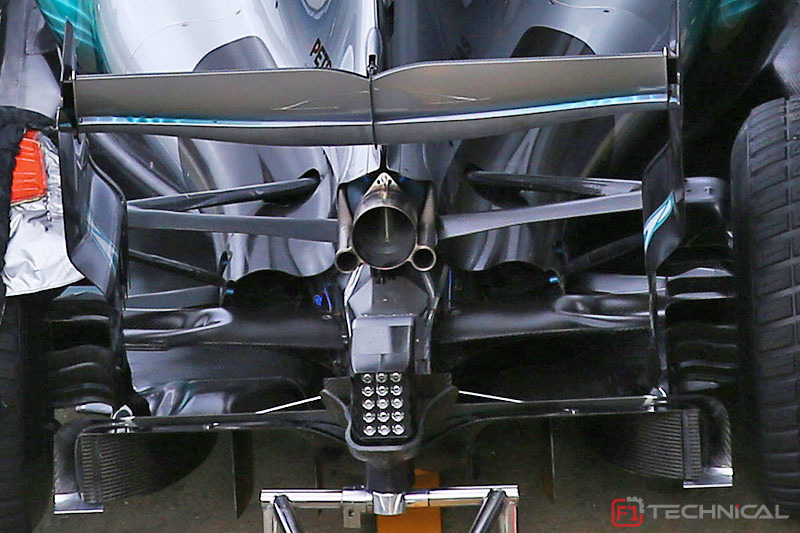Mercedes AMG F1 W08 - Technical impression
Front Wing, Nose and Front Suspension

At the front of the car, the front wing is particularly under impressive and seemingly a simple modification of a 2016 spec wing to fit the new regulations. Hence, it is wider and features a 12.5-degree back-sweep, but other than that, nothing appears to have changed (yet).
The nose cone is a similar story, and doesn't say much about the eventual solution as Mercedes have a history of introducing a different spec nose in pre-season testing. This enables the team to work on it a bit longer and keep their cars close to their body for a longer time. The S-duct entry is just like in 2016 positions just behind the front wing pillars while the exit just immediately ahead and above the upper front wishbone mounts of the front suspension. A notable difference there is Mercedes' copying of McLaren's solution, featuring a much larger exit that is split by the pitot tube support.
That brings us to the front suspension, which is an entirely different story and is a completely new design. When seen from the top, it is clear that apart from the upper front wishbone, all suspension arms are angled forward from the chassis to the wheel in an effort to keep the mounting points aft of the front bulkhead. At the same time, the conjoined lower wishbones were removed, reverting to more conventional layout, with ahead of them the aligned steering rod. Mercedes had this before as well, offering them the advantage of putting the steering elements low down on the monocoque.

The most interesting change however is Mercedes' decision to connect the upper wishbones to a carbon fibre extension on the upright, positioning the king pin off the hub entirely. The team have undoubtedly done this to adapt to the wider front tyres, and it remains to be seen if further changes will be needed as the team learns more about the wider front tyres a the season progresses.
Bargeboard and sidepod
The aerodynamic changes get a bit more radical a behind and below the suspension, with highly detailed bargeboards and appendages in the newly freed up area of the 2017 regulations. As learned lessons cannot be unlearned, the bargeboards look suspiciously similar in philosophy to the ones before 2009, the previous era where so much freedom was allowed in the area.
The main bargeboard consist out of one single piece with a horizontal jiggsaw pattern at its footplate, and a vertical jiggsaw pattern at its upper edges. Above the bargeboard is a very large flow conditioner. Previously this kind of large surfaces were forbidden, but the enlarged bargeboards now open up the scope to put them there.
In combination with the barge boards, which aim to guide air as smoothly as possible around the lower end of the sidepods are large sidepod turning vanes. In addition to the previous bridge over and around leading edge of the sidepod, a further two panels were added, attached to the former via aluminium connections. These metal connections are thing and unidirectionally strong, providing as little airflow disruption as possible in the two slits that are created by the 3 panels. Renault appears to have been thinking in a similar direction, but their solution on the launched RS17 are quite a bit less elaborate than what is seen on the F1 W08.

Speaking of the sidepods: these got a bit wider at their widest points as allowed by the regulations, though they do not fill up the full 1600mm width. From there, the sidepods taper to the inside in 2 stages, ultimately leaving a lot of floor clearly visible, which will increase flow over the floor. Also because Mercedes follows the 2017 trend of more aggressive undercutting the sidepods.
Coke Bottle Area

In the coke bottle area, we have a very interesting development as Mercedes has shown a a small and high up winglet in front of the rear wing, dubbed a T-wing. It now seems the FIA left a small unregulated window open between the rear wheel centre line and 50mm ahead of it, between the reference plane and 950mm above it and 750mm from the car centre line, effectively creating a small box where the teams can do as they please. However, with the rear wing right behind it any bodywork could limit flow towards it. It therefore seems that a small wing acting as flow conditioner towards the rear wing seems to be the best solution for now.
Mercedes has not shown a shark fin - yet. It got confirmed they will trial one during testing.
Rear End

Completely at the back we have a very basic diffuser. As probably all other teams, they are not keen to show yet their hand in a very vital area. Do note the rear suspension set up where rear lower wishbone encloses and shrouds the driveshaft, forming one large suspension part which can act as a beam wing.



